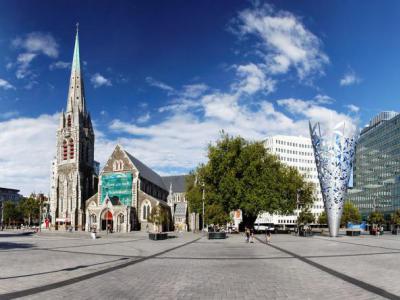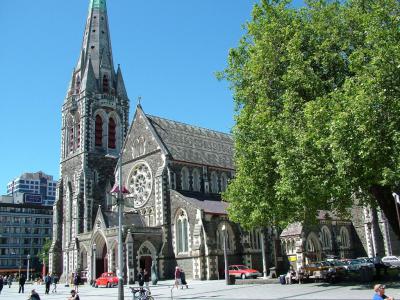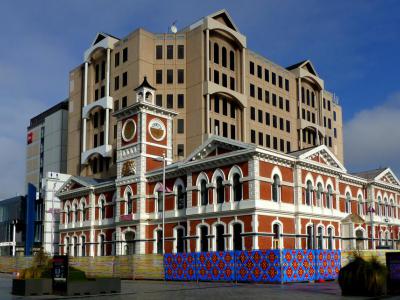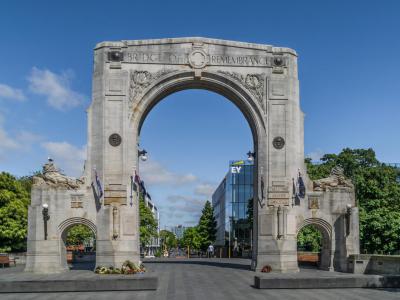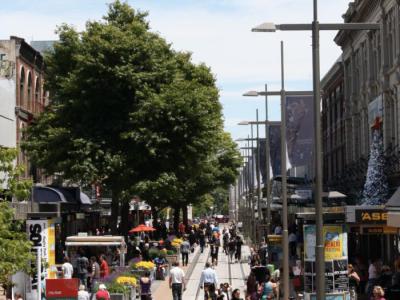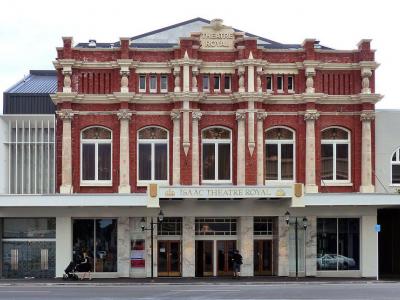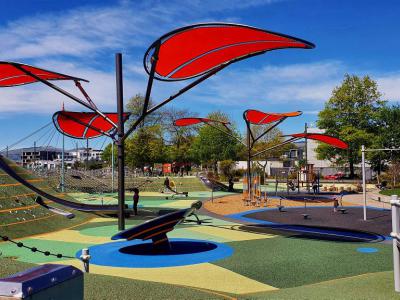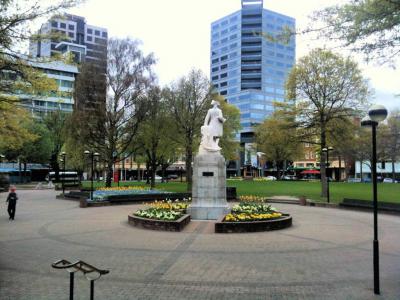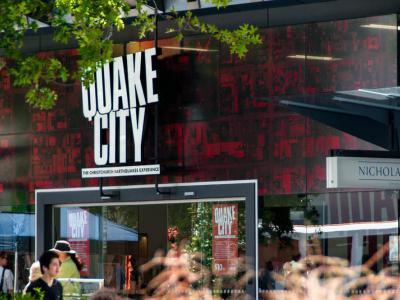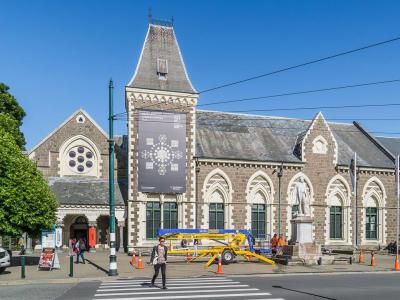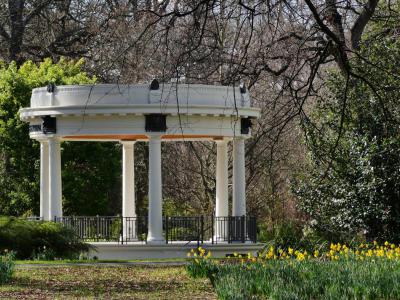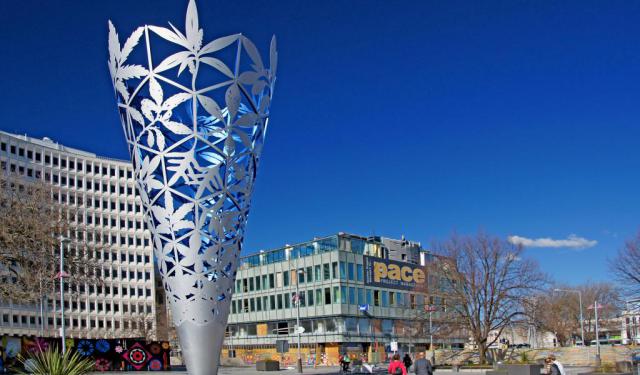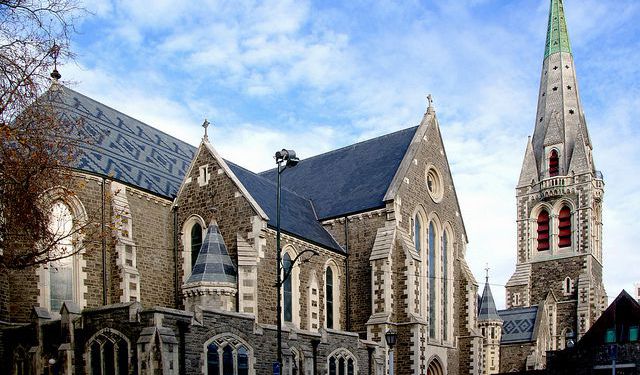
Christchurch Introduction Walking Tour (Self Guided), Christchurch
Captain James Cook was not the first person to discover New Zealand. There is evidence that the Christchurch area was visited by groups of moa-hunting people as early as 1250 AD.
They were followed by the Waitaha from the east coast of the North Island in the 16th century. In a series of wars Waitaha were displaced by the Ngati Mamoe, who in turn were conquered by the Ngai Tahu. The Europeans arrived 600 or so years after the early moa-hunting people. The Weller brothers arrived in 1840. They were whalers from Otago and Sydney.
In 1843 the European immigration began with the arrival of 792 Canterbury pilgrims in four ships in Lyttelton Harbor. The pilgrims hoped to build a city with a cathedral and college modeled after Christ Church in Oxford, England.
Christchurch was declared a city by Royal Charter in 1856. The city was laid out in a grid with Cathedral Square as its center. It was the first chartered city in New Zealand. A great many of of the city's Gothic Revival buildings by Benjamin Mountfort were built following the charter date of 1856.
The city had a lot of room for growth, located between the Pacific in the east and the Port Hills to the south. The urban area grew rapidly, its economy based on agriculture, wool and dairying.
In the center of the city is Cathedral Square. In the center of the square is the earthquake damaged cathedral, facing years of restoration. The earthquakes of 2010 and 2011 devastated the central city, resulting in 185 deaths and many more injured. But the Cathedral Square carries on.
The earthquake damages from the quakes of 2010 and 2011 were far reaching. The Chief Post Office, the City mall, and several office buildings collapsed and many people were killed by falling masonry. Memorials of those lost include the 185 Chairs, the Quake City Exhibit and above all the very moving Canterbury Earthquake National Memorial.
The city begins to revive, mindful of the past and with the ability to meet adversity as well as it ever has.
They were followed by the Waitaha from the east coast of the North Island in the 16th century. In a series of wars Waitaha were displaced by the Ngati Mamoe, who in turn were conquered by the Ngai Tahu. The Europeans arrived 600 or so years after the early moa-hunting people. The Weller brothers arrived in 1840. They were whalers from Otago and Sydney.
In 1843 the European immigration began with the arrival of 792 Canterbury pilgrims in four ships in Lyttelton Harbor. The pilgrims hoped to build a city with a cathedral and college modeled after Christ Church in Oxford, England.
Christchurch was declared a city by Royal Charter in 1856. The city was laid out in a grid with Cathedral Square as its center. It was the first chartered city in New Zealand. A great many of of the city's Gothic Revival buildings by Benjamin Mountfort were built following the charter date of 1856.
The city had a lot of room for growth, located between the Pacific in the east and the Port Hills to the south. The urban area grew rapidly, its economy based on agriculture, wool and dairying.
In the center of the city is Cathedral Square. In the center of the square is the earthquake damaged cathedral, facing years of restoration. The earthquakes of 2010 and 2011 devastated the central city, resulting in 185 deaths and many more injured. But the Cathedral Square carries on.
The earthquake damages from the quakes of 2010 and 2011 were far reaching. The Chief Post Office, the City mall, and several office buildings collapsed and many people were killed by falling masonry. Memorials of those lost include the 185 Chairs, the Quake City Exhibit and above all the very moving Canterbury Earthquake National Memorial.
The city begins to revive, mindful of the past and with the ability to meet adversity as well as it ever has.
How it works: Download the app "GPSmyCity: Walks in 1K+ Cities" from Apple App Store or Google Play Store to your mobile phone or tablet. The app turns your mobile device into a personal tour guide and its built-in GPS navigation functions guide you from one tour stop to next. The app works offline, so no data plan is needed when traveling abroad.
Christchurch Introduction Walking Tour Map
Guide Name: Christchurch Introduction Walking Tour
Guide Location: New Zealand » Christchurch (See other walking tours in Christchurch)
Guide Type: Self-guided Walking Tour (Sightseeing)
# of Attractions: 14
Tour Duration: 2 Hour(s)
Travel Distance: 3.9 Km or 2.4 Miles
Author: Nikki
Sight(s) Featured in This Guide:
Guide Location: New Zealand » Christchurch (See other walking tours in Christchurch)
Guide Type: Self-guided Walking Tour (Sightseeing)
# of Attractions: 14
Tour Duration: 2 Hour(s)
Travel Distance: 3.9 Km or 2.4 Miles
Author: Nikki
Sight(s) Featured in This Guide:
- Cathedral Square
- ChristChurch Cathedral
- Chief Post Office
- Bridge of Remembrance
- City Mall
- 185 Empty Chairs
- Cardboard Cathedral
- Isaac Theatre Royal
- New Regent Street
- Margaret Mahy Playground
- Victoria Square
- Quake City
- Canterbury Museum
- Christchurch Botanic Gardens
1) Cathedral Square
Cathedral Square, locally known simply as the Square, is the geographical centre and heart of Christchurch.
It was intended that Cathedral Square be named for Protestant martyr Nicholas Ridley, burned at the stake in 1555. Ridley's fellow martyrs, Cranmer and Latimer, have their squares but Ridley's square was envisaged for ChristChurch Cathedral in 1850.
The square was planned in the form of a cross. It was originally conceived as a private area for the Cathedral and a grammar school. However, from the very beginning, the square became a place for meetings and communal events. In 1974 the square was redeveloped. In 2000 Gray tiles were laid, making a grid pattern over an enormous area.
The square is a magnet for colorful characters. Ian Brackenbury, aka "The Wizard", mounts a ladder and begins his discourse. He wears a tall, pointed witch's hat and a black academic gown and he claims to be a false prophet of the Church of England. Then there's the Bible Lady, Renee Stanton. She competes with the false prophet for attention.
Cathedral Square has a large number of historical buildings and statues that are registered as heritage items with Heritage New Zealand. Among them are the ChristChurch Cathedral, Press Building, former Chief Post Office, Old Government Building, Citizens' War Memorial, Godley Statue and others.
In 2011 a disastrous earthquake rocked Christchurch. ChristChurch Cathedral, The crown jewel of the square, was left a gutted ruin. It is still in a damaged state today but plans are to restore it and not to pull it down. Some of the other historical buildings are also damaged by the earthquake.
Today the square is alive with visitors and buskers, food kiosks and hope.
It was intended that Cathedral Square be named for Protestant martyr Nicholas Ridley, burned at the stake in 1555. Ridley's fellow martyrs, Cranmer and Latimer, have their squares but Ridley's square was envisaged for ChristChurch Cathedral in 1850.
The square was planned in the form of a cross. It was originally conceived as a private area for the Cathedral and a grammar school. However, from the very beginning, the square became a place for meetings and communal events. In 1974 the square was redeveloped. In 2000 Gray tiles were laid, making a grid pattern over an enormous area.
The square is a magnet for colorful characters. Ian Brackenbury, aka "The Wizard", mounts a ladder and begins his discourse. He wears a tall, pointed witch's hat and a black academic gown and he claims to be a false prophet of the Church of England. Then there's the Bible Lady, Renee Stanton. She competes with the false prophet for attention.
Cathedral Square has a large number of historical buildings and statues that are registered as heritage items with Heritage New Zealand. Among them are the ChristChurch Cathedral, Press Building, former Chief Post Office, Old Government Building, Citizens' War Memorial, Godley Statue and others.
In 2011 a disastrous earthquake rocked Christchurch. ChristChurch Cathedral, The crown jewel of the square, was left a gutted ruin. It is still in a damaged state today but plans are to restore it and not to pull it down. Some of the other historical buildings are also damaged by the earthquake.
Today the square is alive with visitors and buskers, food kiosks and hope.
2) ChristChurch Cathedral
ChristChurch Cathedral is in the middle of Cathedral Square. The Cathedral is the child of the Canterbury Association, founded by Parliament and the Anglican Church. Under the leadership of John Robert Godley, Anglo-Irish statesman, the colony of Christchurch became a reality in 1850.
In 1858 The Anglican diocese commissioned architect George Gilbert Scott to design the Cathedral. It was to be built in Scott's Gothic Revival style. The cornerstone was laid in 1864, but budget restraints halted construction in 1865. In 1873 New Zealand architect Benjamin Mountfort took over.
The 100 foot nave and tower were consecrated in 1881. The chancel, transepts and apse were finished in 1904. The tower and spire of the cathedral reached a height of 207 feet above the square. The cathedral was an all-stone construction.
From 1881 through 2011 the Cathedral was wracked by earthquakes. In 2011 a 6.3 magnitude earthquake in February left the Cathedral in ruins. The spire was destroyed completely. After a 6.4 magnitude quake in June, the walls partially fell in. In 2012 it was announced the building would be demolished.
After much litigation, in September of 2017 Bishop Victoria Mathews announced the Cathedral would be reinstated. The reconstruction would take an estimated 10 years.
In 1858 The Anglican diocese commissioned architect George Gilbert Scott to design the Cathedral. It was to be built in Scott's Gothic Revival style. The cornerstone was laid in 1864, but budget restraints halted construction in 1865. In 1873 New Zealand architect Benjamin Mountfort took over.
The 100 foot nave and tower were consecrated in 1881. The chancel, transepts and apse were finished in 1904. The tower and spire of the cathedral reached a height of 207 feet above the square. The cathedral was an all-stone construction.
From 1881 through 2011 the Cathedral was wracked by earthquakes. In 2011 a 6.3 magnitude earthquake in February left the Cathedral in ruins. The spire was destroyed completely. After a 6.4 magnitude quake in June, the walls partially fell in. In 2012 it was announced the building would be demolished.
After much litigation, in September of 2017 Bishop Victoria Mathews announced the Cathedral would be reinstated. The reconstruction would take an estimated 10 years.
3) Chief Post Office
In 1863 it was decided Christchurch would replace Lyttelton as the main Post Town. Christchurch's post office was too small and located in Market Square, later known as Victoria Square. Architect William Henry Clayton would design the Christchurch Post Office.
The design of the building is Italianate with Venetian Gothic touches. The upper windows have pointed arches. A four faced clock turret clock was installed in the Post Office tower in 1879. It is thought to be an imitation of London's Great Clock of Westminster. On the east face of the tower, under the clock, is the coat of arms of the United Kingdom.
Like other buildings on the Square, the Chief Post Office has suffered quake damages over the years. It has lost tenants since the devastating quake of 2011. In 2018 came the announcement that the building would be repaired and restored. Building Owner Gordon Chamberlain said the process would take about two years.
Scheduled repairs include the facade and clock tower, overall strengthening and replacing the roof.
The design of the building is Italianate with Venetian Gothic touches. The upper windows have pointed arches. A four faced clock turret clock was installed in the Post Office tower in 1879. It is thought to be an imitation of London's Great Clock of Westminster. On the east face of the tower, under the clock, is the coat of arms of the United Kingdom.
Like other buildings on the Square, the Chief Post Office has suffered quake damages over the years. It has lost tenants since the devastating quake of 2011. In 2018 came the announcement that the building would be repaired and restored. Building Owner Gordon Chamberlain said the process would take about two years.
Scheduled repairs include the facade and clock tower, overall strengthening and replacing the roof.
4) Bridge of Remembrance
Edward George Wright, civil engineer, was commissioned to build a bridge over the river Avon at Cashel Street in Christchurch in 1873. The bridge became pedestrianized in 1977 and it links Oxford and Cambridge Terraces over the Avon. In 1919, as World War I ended, Mrs Wyn Irwin, secretary of the Bridge of Remembrance Committee, wrote to The Press suggesting a memorial arch on the bridge.
The Memorial Arch was unveiled by Lord Jellicoe, hero of the Battle of Jutland, in November 1924. Soldiers crossed over the Avon this way in the Great War, on their way to the railway station and then by ship to the front.
The design was by William Gummer. Gummer had designed other memorials including the Dunedin Cenotaph war memorial. The central frame of the Remembrance Bridge memorial has the inscription "Quid non-pro Patria" ("What will a man not do for his country"). The arch is adorned with a cross, torches, coat of arms, laurel wreaths and stone lions.
On April 2, 1985 the Bridge of Remembrance was listed as a Category I with the New Zealand Historic Places Trust.
The Memorial Arch was unveiled by Lord Jellicoe, hero of the Battle of Jutland, in November 1924. Soldiers crossed over the Avon this way in the Great War, on their way to the railway station and then by ship to the front.
The design was by William Gummer. Gummer had designed other memorials including the Dunedin Cenotaph war memorial. The central frame of the Remembrance Bridge memorial has the inscription "Quid non-pro Patria" ("What will a man not do for his country"). The arch is adorned with a cross, torches, coat of arms, laurel wreaths and stone lions.
On April 2, 1985 the Bridge of Remembrance was listed as a Category I with the New Zealand Historic Places Trust.
5) City Mall
City Mall, located in the heart of Christchurch, New Zealand, is the principal pedestrian thoroughfare within the central city. It encompasses two segments of Cashel Street, including the Bridge of Remembrance, and a portion of High Street, earning it the colloquial name, Cashel Mall. The transformation of this area into a pedestrian-friendly zone began with the pedestrianization of the Bridge of Remembrance in 1976. The main mall area followed suit, ceasing vehicle traffic on January 11, 1982, and officially reopening as a pedestrian mall on August 7 of the same year.
Between 2006 and 2009, City Mall underwent significant redevelopment, which included the installation of tram tracks to extend the heritage tram network, highlighting its status as a central hub for both shopping and cultural heritage. Despite its importance and historical value, the mall faced several challenges due to natural disasters. The February 2011 earthquake, with a magnitude of 6.3, brought devastating impacts to the mall, leading to the collapse of many building façades and resulting in fatalities. This disaster prompted the closure of the city center to facilitate demolition and rebuilding efforts.
Most of the heritage buildings within the mall, which were registered by Heritage New Zealand, suffered during these earthquakes. Despite these challenges, the resilience of Christchurch and its people shone through. The Cashel Street section from Oxford Terrace to Colombo Street became the first part of the central city to reopen on October 29, 2011. The City Mall was reopened to the public in 2018.
Between 2006 and 2009, City Mall underwent significant redevelopment, which included the installation of tram tracks to extend the heritage tram network, highlighting its status as a central hub for both shopping and cultural heritage. Despite its importance and historical value, the mall faced several challenges due to natural disasters. The February 2011 earthquake, with a magnitude of 6.3, brought devastating impacts to the mall, leading to the collapse of many building façades and resulting in fatalities. This disaster prompted the closure of the city center to facilitate demolition and rebuilding efforts.
Most of the heritage buildings within the mall, which were registered by Heritage New Zealand, suffered during these earthquakes. Despite these challenges, the resilience of Christchurch and its people shone through. The Cashel Street section from Oxford Terrace to Colombo Street became the first part of the central city to reopen on October 29, 2011. The City Mall was reopened to the public in 2018.
6) 185 Empty Chairs (must see)
Christchurch was staggered by the Earthquake of February, 2011 and 185 people died. On the first anniversary of the quake, Peter Majendie, a local artist, set up 185 chairs. The chairs were painted white. Peter arranged the chairs on the site of the demolished Oxford Terrace Baptist Church. The chairs did not go unnoticed.
In October of that year the exhibit moved to the location of demolished Saint Paul's Church. This location is opposite the CTV Building. It was in this building that 115 people died.
The chairs are of differing styles and types. Peter's idea was an homage to Vincent Van Gogh's painting of chairs reflecting the different personalities of their owners. This is an installation that does not need words to explain itself. Arranged in rows, on green turf, the chairs invite visitors to walk among them, to share experiences.
The White Chairs of Majendie have inspired uncounted responses from around the world. It is a moving memorial to the loss of the 185 and the emptiness left behind. Today these 185 Empty Chairs are a top attraction in Christchurch.
In October of that year the exhibit moved to the location of demolished Saint Paul's Church. This location is opposite the CTV Building. It was in this building that 115 people died.
The chairs are of differing styles and types. Peter's idea was an homage to Vincent Van Gogh's painting of chairs reflecting the different personalities of their owners. This is an installation that does not need words to explain itself. Arranged in rows, on green turf, the chairs invite visitors to walk among them, to share experiences.
The White Chairs of Majendie have inspired uncounted responses from around the world. It is a moving memorial to the loss of the 185 and the emptiness left behind. Today these 185 Empty Chairs are a top attraction in Christchurch.
7) Cardboard Cathedral (must see)
The dust from the 2011 Christchurch earthquake had barely settled when the well known Japanese "disaster architect" Shigaru Ban was invited to Christchurch to design a temporary cathedral. The cathedral needed to be capable of holding concerts and events as well as services. Ban created the design pro bono.
The "Cardboard Cathedral" is an A-frame style building. The roof is 69 feet above the altar. Materials include wood, steel, and 96 24-inch diameter waterproof cardboard tubes. Eight shipping containers provide the walls and the roof is polycarbonate. The foundation is a concrete slab. The cathedral can hold up to 700 people.
It is the only cathedral in the world made substantially of cardboard. Its environmentally conscious use of paper tubes as an architectural material has drawn acclaims from around the world.
Lonely Planet named Christchurch one of the "top 10 cities to travel" in October 2012, and the cathedral was cited as one of the reasons that makes the city an exciting place.
The "Cardboard Cathedral" is an A-frame style building. The roof is 69 feet above the altar. Materials include wood, steel, and 96 24-inch diameter waterproof cardboard tubes. Eight shipping containers provide the walls and the roof is polycarbonate. The foundation is a concrete slab. The cathedral can hold up to 700 people.
It is the only cathedral in the world made substantially of cardboard. Its environmentally conscious use of paper tubes as an architectural material has drawn acclaims from around the world.
Lonely Planet named Christchurch one of the "top 10 cities to travel" in October 2012, and the cathedral was cited as one of the reasons that makes the city an exciting place.
8) Isaac Theatre Royal
The Canterbury Music Hall opened on Glouster Street on Boxing Day, December 26, 1861. It was nothing too fancy, just a barn adapted to serve as a theater. In less than two years it was renamed the Royal Princess Theatre in honor of Princess Alexandra of Denmark. She had married the future Edward VII, King of Great Britain.
Ultimately the theater became, simply, the Theatre Royal. In 1876 the theater was replaced by a new Theatre Royal. Finally, in 1908, on a site across the road, an even newer Theatre Royal arose. The even newer theater became a model of survival and restoration and New Zealand's only operating Edwardian Theatre.
The Theatre was designed by Sidney and Alfred Lutrell in the Edwardian style. In 1928 it was adapted for motion pictures. Important earthquake strengthening and remodeling was done in 2000, 2004 and 2006. A modern concrete fly tower replaced the old backstage area. The proscenium and stage were enlarged and the house was upgraded.
During the renovations of 2005 The theater became the Isaac Theatre Royal. The new name was in honor of Lady Diana Isaac, a long time generous patron of the arts in New Zealand. The Theatre was severely damaged in the earthquake of 2011. It was closed for a few years for restorations. It reopened in November 2014.
Ultimately the theater became, simply, the Theatre Royal. In 1876 the theater was replaced by a new Theatre Royal. Finally, in 1908, on a site across the road, an even newer Theatre Royal arose. The even newer theater became a model of survival and restoration and New Zealand's only operating Edwardian Theatre.
The Theatre was designed by Sidney and Alfred Lutrell in the Edwardian style. In 1928 it was adapted for motion pictures. Important earthquake strengthening and remodeling was done in 2000, 2004 and 2006. A modern concrete fly tower replaced the old backstage area. The proscenium and stage were enlarged and the house was upgraded.
During the renovations of 2005 The theater became the Isaac Theatre Royal. The new name was in honor of Lady Diana Isaac, a long time generous patron of the arts in New Zealand. The Theatre was severely damaged in the earthquake of 2011. It was closed for a few years for restorations. It reopened in November 2014.
9) New Regent Street
New Regent Street is a pedestrian mall lined with Spanish Mission style shop houses with shaped gables, medallions, tiled window hoods, barley-twist columns and roofed arcades. The houses alternate in light pastel colors of yellow, pale blue and green. The effect is reminiscent of southern California or Granada.
The street was built in the late 1930s with 40 shops. Developing small shops as a compound or complex was an advanced idea. Some say it was a precursor to the modern shopping mall of today.
The original name proposed was Little High Street, referencing High Street south of the city center. The builders suggested Regent Street, as with Regent Street in London. There was a Regent street already in Sydenham, a suburb of Christchurch, so everyone went with New Regent Street. All the buildings are listed as Category I heritage sites.
The street was pedestrianized in 1994 in anticipation of the coming of the Christchurch heritage pram (electric trolly). The pram began operating in the street in 1995. The street offers bars, cafes, waffle houses, jewelers, dance wear boutiques and gelato stores.
The 2011 earthquake caused damage to some of the buildings on the New Regent Street, but most of the damages have been repaired. The street is once again a popular place to go for shopping, dining and people watching.
The street was built in the late 1930s with 40 shops. Developing small shops as a compound or complex was an advanced idea. Some say it was a precursor to the modern shopping mall of today.
The original name proposed was Little High Street, referencing High Street south of the city center. The builders suggested Regent Street, as with Regent Street in London. There was a Regent street already in Sydenham, a suburb of Christchurch, so everyone went with New Regent Street. All the buildings are listed as Category I heritage sites.
The street was pedestrianized in 1994 in anticipation of the coming of the Christchurch heritage pram (electric trolly). The pram began operating in the street in 1995. The street offers bars, cafes, waffle houses, jewelers, dance wear boutiques and gelato stores.
The 2011 earthquake caused damage to some of the buildings on the New Regent Street, but most of the damages have been repaired. The street is once again a popular place to go for shopping, dining and people watching.
10) Margaret Mahy Playground (must see)
Within an easy walk from the center of Christchurch one finds the Margaret Mahy Playground. Margaret Mahy was a world famous children's book author. She died on July 23 2012. The playground is probably the largest playground in the Southern Hemisphere.
The playground offers serious fun for all children and a break for the adults. There are bouncing slides, climbing, flying fox squirting, picture swings and a small water park, plus food carts and BBQs. The park borders the Avon River and New Regent Street is nearby.
The park covers a wide selection of play equipment. The team designers created a "story arc" path almost 500 feet long. The arc contains elements from the children's stories of writers Margaret Mahy and Elsie Locke. Legends and images from the indigenous Ngai Tahu people also appear in the arc.
Much of the equipment is custom made. A 33 foot high tower, a 15 foot climbing slope with slides, in-ground trampolines and "flying fox" machines and other fun items abound, water play, climbing nets and even artworks add to the many possibilities for children and adults.
The playground offers serious fun for all children and a break for the adults. There are bouncing slides, climbing, flying fox squirting, picture swings and a small water park, plus food carts and BBQs. The park borders the Avon River and New Regent Street is nearby.
The park covers a wide selection of play equipment. The team designers created a "story arc" path almost 500 feet long. The arc contains elements from the children's stories of writers Margaret Mahy and Elsie Locke. Legends and images from the indigenous Ngai Tahu people also appear in the arc.
Much of the equipment is custom made. A 33 foot high tower, a 15 foot climbing slope with slides, in-ground trampolines and "flying fox" machines and other fun items abound, water play, climbing nets and even artworks add to the many possibilities for children and adults.
11) Victoria Square
Victoria Square was at first, Market Square. Maori people came to this area on the banks of the Avon River to market their produce. A 20-foot high totem was erected on the square in 1994. It was carved by artist Riki Manuel. It memorializes the presence of the first people.
Victoria Square was the commercial dynamo of early Christchurch. It held the Post Office, various markets, the Police Station, Women's Prison, an animal pound, store houses and Immigration Barracks. In May of 1903 the statue of Queen Victoria was unveiled in Market Square and the square became Victoria Square.
In March 1852 a simple bridge was erected over the Avon River. It was called the Market Place Bridge. It was replaced in 1864 by a bridge of iron and stone which still stands today. It was named Victoria Bridge. In 1989 it was renamed Hamish Hay Bridge.
Near the statue of Queen Victoria is Mana Motuhake, carved by Fayne Robinson. It honors the signing of the Treaty of Waitangi, which settled British and Maori governance of New Zealand. It consists of two upright canoe hulls (waka) holding carved figures mounted on a stone plinth.
Other monuments include the Floral Clock, using 7,000 plants each spring and autumn and the H.L. Bowker Fountain, designed by Victor Dean in 1931. Finally there is the marble statue of Captain James Cook, made by William Trethewey, commemorating his three voyages to New Zealand.
Victoria Square was the commercial dynamo of early Christchurch. It held the Post Office, various markets, the Police Station, Women's Prison, an animal pound, store houses and Immigration Barracks. In May of 1903 the statue of Queen Victoria was unveiled in Market Square and the square became Victoria Square.
In March 1852 a simple bridge was erected over the Avon River. It was called the Market Place Bridge. It was replaced in 1864 by a bridge of iron and stone which still stands today. It was named Victoria Bridge. In 1989 it was renamed Hamish Hay Bridge.
Near the statue of Queen Victoria is Mana Motuhake, carved by Fayne Robinson. It honors the signing of the Treaty of Waitangi, which settled British and Maori governance of New Zealand. It consists of two upright canoe hulls (waka) holding carved figures mounted on a stone plinth.
Other monuments include the Floral Clock, using 7,000 plants each spring and autumn and the H.L. Bowker Fountain, designed by Victor Dean in 1931. Finally there is the marble statue of Captain James Cook, made by William Trethewey, commemorating his three voyages to New Zealand.
12) Quake City (must see)
The 2011 Christchurch earthquake was a 6.3 magnitude quake. It is thought to have been an aftershock of the September 2010 Canterbury quake. It was smaller than the September earthquake but its epicenter was closer to the center of the city and closer to ground level. Hundreds of people died any many more were injured.
The treasures (taongas) on display at Quake City help to tell the stories of the Canterbury earthquakes. Quake City is a special exhibit of the Canterbury Museum. The exhibit was created in response to a high public interest in learning of the earthquake experiences of 2010-2011 in Christchurch.
In the exhibit visitors may learn something of the science of the earthquakes. A hands-on interactive exhibit tells the story of liquefaction: when the ground literally liquefies from the shaking, rising up to bury streets and buildings.
There are objects salvaged from the ruins, like the broken spire of Christchurch Cathedral, a bell from the Cathedral of the Blessed Sacrament and clocks from the obliterated railway station.
Quake City also records the acts of the heroic responders of the emergency services and the thousands of ordinary citizens who joined rescue efforts.
The Exhibit exemplifies the Museum's role as a guardian (kaitiaki) of the history and treasures of the region of Canterbury.
The treasures (taongas) on display at Quake City help to tell the stories of the Canterbury earthquakes. Quake City is a special exhibit of the Canterbury Museum. The exhibit was created in response to a high public interest in learning of the earthquake experiences of 2010-2011 in Christchurch.
In the exhibit visitors may learn something of the science of the earthquakes. A hands-on interactive exhibit tells the story of liquefaction: when the ground literally liquefies from the shaking, rising up to bury streets and buildings.
There are objects salvaged from the ruins, like the broken spire of Christchurch Cathedral, a bell from the Cathedral of the Blessed Sacrament and clocks from the obliterated railway station.
Quake City also records the acts of the heroic responders of the emergency services and the thousands of ordinary citizens who joined rescue efforts.
The Exhibit exemplifies the Museum's role as a guardian (kaitiaki) of the history and treasures of the region of Canterbury.
13) Canterbury Museum (must see)
Canterbury Museum may be found in the center of Christchurch. It was founded in 1867 by Julius von Haast, an explorer and geologist. The Museum was based mainly on von Haast's own collections. The museum is a Victorian Gothic Revival building, designed by Benjamin Mountfort, a prominent New Zealand architect dedicated to all things Gothic.
The museum never stopped growing. By 1876 another building had been added and an inner courtyard, which was roofed over in 1882. A new wing was added in 1958, next to Christ's College. Another wing came along in 1977. Strengthening measures were taken in the 1990s. A four-storey section was built in 1995.
The museum experienced some damage to its facade in the earthquakes of 2010-2011, but it still emerged in sound condition. Almost all of the collections were undamaged. The statue of William Rolleston, however, was knocked off its plinth. Rolleston was the superintendent of Canterbury Province until 1877.
The Museum show-cases displays on Antarctica, costumes, indigenous birds, and the history of the Maori and European peoples in New Zealand. Also covered are Asian decorative arts, geology and natural sciences. Access is also available to research materials.
The museum never stopped growing. By 1876 another building had been added and an inner courtyard, which was roofed over in 1882. A new wing was added in 1958, next to Christ's College. Another wing came along in 1977. Strengthening measures were taken in the 1990s. A four-storey section was built in 1995.
The museum experienced some damage to its facade in the earthquakes of 2010-2011, but it still emerged in sound condition. Almost all of the collections were undamaged. The statue of William Rolleston, however, was knocked off its plinth. Rolleston was the superintendent of Canterbury Province until 1877.
The Museum show-cases displays on Antarctica, costumes, indigenous birds, and the history of the Maori and European peoples in New Zealand. Also covered are Asian decorative arts, geology and natural sciences. Access is also available to research materials.
14) Christchurch Botanic Gardens (must see)
In 1863 an English oak tree was planted in an area of land just south of Hagley Park in Christchurch. The tree was planted for two reasons: 1) To inaugurate the Christchurch Botanic Gardens; and 2) To honor the marriage of Prince Albert of England and Princess Alexandra of Denmark. The marriage prospered and the park grew.
The garden ranges over 21 hectares by the Avon River. It has a variety of exotic and local plants, conservatories, a nursery, a playground and a climate station. The visitor center, opened in 2014, has a gift shop, cafe and an interactive exhibition on the history of gardening. Next door is the Ilex Nursery, home to 10,000 plant species.
The Armstrong Lawn has formal beds of flowers throughout the seasons. The Peacock Fountain, imported from England, is installed on the Lawn. The Curator's House (1920), also on the Lawn, has its own kitchen garden of flowers and vegetables.
Trails and formal paths wander about the park, bringing visitors through many different gardens and environments. The herbaceous border of the gardens is divided by an ornamental sundial. The gardens feature plants of different climates and regions. The Central Rose Garden has 104 beds holding a profuse collection of roses.
The Rock Garden's terraces are ideal for alpine plants. There is the Azalea and Magnolia Garden, canopied by oak and birch trees. There are gardens of heritage roses, the Temperate Asian Collection, and the Water Garden. Woodlands are represented in the Daffodil Woodland, the Woodland Garden and the arboretum of pine trees, called the Pinetum.
There are ornamental buildings, pavilions and follies, and the Bandsmen's Memorial Rotunda. Conservatories are the Cunningham House, the Townend House, the Garrick House, the Gilpin house, the Fern House and the Foweraker House. The conservatories shelter tropical plants, ferns, cacti and desert flora and water plants.
All this, and including a popular children's playground, a climatological station and a cafe are open to visitors.
The garden ranges over 21 hectares by the Avon River. It has a variety of exotic and local plants, conservatories, a nursery, a playground and a climate station. The visitor center, opened in 2014, has a gift shop, cafe and an interactive exhibition on the history of gardening. Next door is the Ilex Nursery, home to 10,000 plant species.
The Armstrong Lawn has formal beds of flowers throughout the seasons. The Peacock Fountain, imported from England, is installed on the Lawn. The Curator's House (1920), also on the Lawn, has its own kitchen garden of flowers and vegetables.
Trails and formal paths wander about the park, bringing visitors through many different gardens and environments. The herbaceous border of the gardens is divided by an ornamental sundial. The gardens feature plants of different climates and regions. The Central Rose Garden has 104 beds holding a profuse collection of roses.
The Rock Garden's terraces are ideal for alpine plants. There is the Azalea and Magnolia Garden, canopied by oak and birch trees. There are gardens of heritage roses, the Temperate Asian Collection, and the Water Garden. Woodlands are represented in the Daffodil Woodland, the Woodland Garden and the arboretum of pine trees, called the Pinetum.
There are ornamental buildings, pavilions and follies, and the Bandsmen's Memorial Rotunda. Conservatories are the Cunningham House, the Townend House, the Garrick House, the Gilpin house, the Fern House and the Foweraker House. The conservatories shelter tropical plants, ferns, cacti and desert flora and water plants.
All this, and including a popular children's playground, a climatological station and a cafe are open to visitors.
Walking Tours in Christchurch, New Zealand
Create Your Own Walk in Christchurch
Creating your own self-guided walk in Christchurch is easy and fun. Choose the city attractions that you want to see and a walk route map will be created just for you. You can even set your hotel as the start point of the walk.
Statues and Memorials Tour
Although Christchurch is not very large, it has a wealth of public art heritage. Although ravaged by a powerful earthquake in 2011, which caused severe damage to many local attractions, Christchurch nonetheless has retained much of its charm and has a lot to offer visitors in terms of sightseeing. Indeed, there is no shortage of beautiful buildings, parks, gardens and other places of interest... view more
Tour Duration: 1 Hour(s)
Travel Distance: 1.4 Km or 0.9 Miles
Tour Duration: 1 Hour(s)
Travel Distance: 1.4 Km or 0.9 Miles
The Most Popular Cities
/ view all
